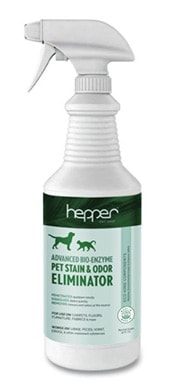How to Remove Black Urine Stains from Hardwood Floors: 10 Practical Options
-

- Last updated:

We love our pets unconditionally, but accidents happen. The alkaline properties of pet urine can leave a black urine stain on your hardwood floor. It is a headache, but we’ve got good news! If you know which solutions to use, you can remove these stains with minimal elbow grease.
You won’t need fancy equipment or chemicals that cost a fortune. Instead, we will focus on the most common, widely available solutions and go from there. First, we will talk about kitchen products, including baking soda, grapefruit oil, and even soap. Next, we’ll dive into the “heavy artillery”: bleach, sanding, peroxide, and more. We’ve done the research and are happy to share our top picks with you. Let’s get started!
Everyday Kitchen Products: Baking Soda, Soap, and Vinegar
Baking soda and vinegar are generally considered kitchen staples. But what if we told you these ingredients could remove urine stains? That’s right! So, before we get into more radical methods, let’s see how effective the most common products can be against this oh-so-common problem for pet lovers.

1. Start by Cleaning the Floor
The sooner you get to a pet accident, the better. Urine shouldn’t stain on contact, but if it has time to set, wiping the puddle probably won’t do much good. On the other hand, if the “crime scene” is fresh and the puddle is small, this could actually work.
Step 1: Use an old, absorbent cloth, paper towel, or sponge mop to soak up the puddle of urine.
Step 2: Dampen some paper towel with water and wipe the spot again.
Step 3: Take some cloth or towel to dry the area.
2. Try Basic Baking Soda
As a natural absorbent, baking soda is quite effective against floor stains (and not only left by pet urine). On top of that, it’s also an odor detergent. That’s right: instead of masking the bad smell, it eliminates the source of that hideous fragrance. By soaking moisture, it can handle big puddles of liquid, especially from a smooth, sleek surface like hardwood.
So, if you just witnessed your furry four-legged friend do the deed, grab that soda from your kitchen shelves and cover the stain with it. Keep sprinkling until the entire stain is buried in soda—but don’t overdo it. Next, give it some time to sit and do its thing. An hour should do; in severe situations, leave the soda overnight, then scrub the area with a bristle brush. Go over the spot with a vacuum cleaner to finish the job.
Don’t forget to rinse the area and then use a microfiber cloth to dry the floor.
3. White/Cleaning Vinegar Might Help
Pet lovers are used to having soiled areas on the floor, and in most cases, they try to “handle” that by wiping the spot and/or adding some soda. Unfortunately, black urine stains aren’t always easy to remove, and that’s when vinegar comes in. This common kitchen ingredient is a product of fermentation plus a natural disinfectant. It’s great at eliminating stubborn pet urine stains.
Just like baking soda, vinegar is a strong deodorant. Go ahead and mix one cup of vinegar with a bucket full of lukewarm water. Next, dip your non-abrasive brush (or a sponge) into the mix and get to scrubbing. Keep at it until the stain goes away. Finally, rinse the area, dry the floor with a clean, dry cloth/towel, and you’re done.
This is important: white vinegar is 95% water and 5% acetic acid, while cleaning vinegar is 94% water and 6% acid. That extra 1% makes cleaning vinegar up to 20% more effective. Do remember, though, that cleaning vinegar is NOT recommended for consumption or use in cooking.
4. What About Grapefruit Oil?
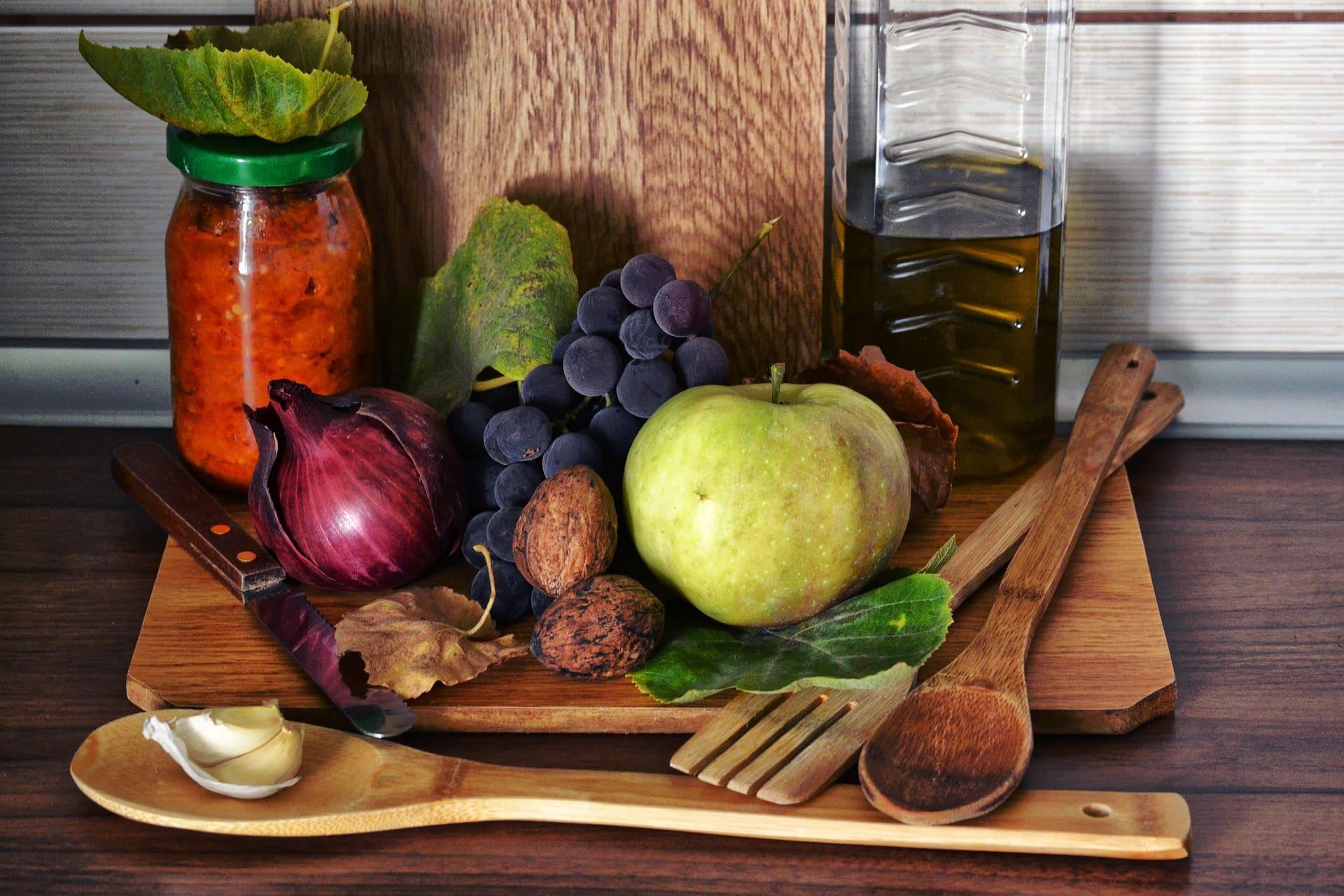
Don’t have any vinegar in the house? That’s ok, as long as you’ve got some grapefruit oil stashed in the kitchen. In many ways, it’s similar to vinegar but slightly less effective. The best thing about it—grapefruit oil is 100% safe. It only needs ten minutes to kick in and is quite effective against odors. Yes, it’s also a natural cleaner with antibacterial properties. Grapefruit oil is more effective against grease than anything else.
But, when mixed with vinegar or baking soda, it does a great job of boosting its efficiency. Therefore, you should always try to mix these three ingredients for the best results.
5. Dish Soap Could Be the Answer
The #1 job of dish soap is to clean dishes. So, why not try it on pet pee? It’s strong against bacteria and has proven to be effective against couch and carpet stains. However, it’s weak against stubborn black urine stains on its own. Again, to fix that, mix it with soda or vinegar. You’ll only need a few drops of it. Dip your brush into the mix, wipe the stain, give the solution five minutes to soak the urine in, and finish up with a dry towel or cotton cloth.
The Heavy Artillery: Chemicals, Cleaning Products, and More
Do you feel like the basic stuff from your kitchen fails at removing stubborn stains? That means only one thing: you need to invest in cleaning products and chemical compounds that were specifically designed to be effective against black urine stains. You probably already have Hydrogen Peroxide in your bathroom cabinet, along with some sandpaper and bleach in the garage. So, these won’t even cost you anything.
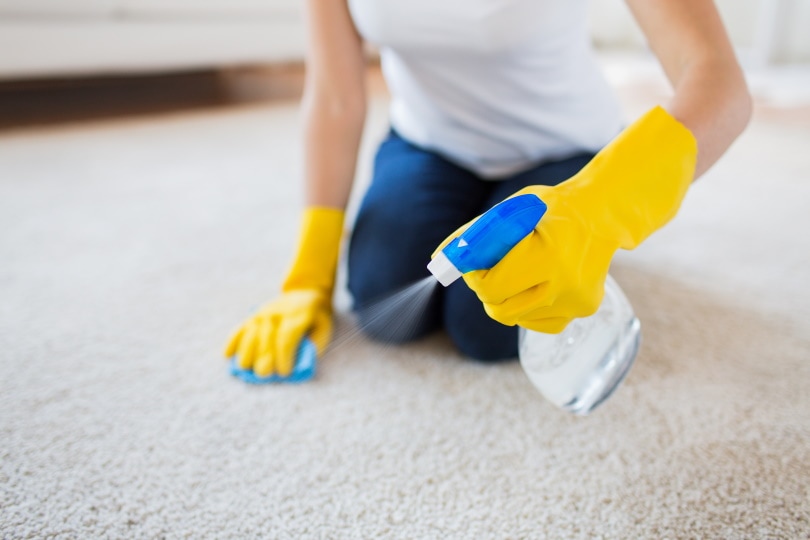
6. Hydrogen Peroxide: Effective, Yet Dangerous
If you’re “late to the party”, and the urine has already been absorbed into the floor, hydrogen peroxide is what can help you get rid of the stains. This mild antiseptic is mostly used against burns and infection and is very effective as a bleaching agent. Start by soaking a brush/towel in peroxide, then scrub the stain and let it dry. If the stain is stubborn, try covering it with a towel. Go about your business and come back to check on it in an hour or two.
You might have to give the towel 10–12 hours to get the job done. The biggest downside—hydrogen leaves tiny stains of its own; yes, you might have to refinish the floor unless it’s light-colored. In its pure form, peroxide is a hard agent that can damage the skin. But, if you only use 3% peroxide that they sell at pharmacies, it won’t cause any harm. Oh, and do mix it with a bucket of water, soda, and dish soap for an even better effect.
7. Why Not Go With an Enzymatic Cleaner?
This non-toxic cleaning product is specifically designed and formulated to break down stubborn stains. There are different types of enzymatic cleaners on the market. Some are strong against fats, while others specialize in carbohydrates. And then, there are solutions mixed with one goal in mind: to remove pet urine stains and odor. Before you get to it, take a minute to check the included instructions.
You probably won’t achieve the desired effect by just wiping the stain with a soaked brush, towel, or sponge. However, if you put some effort into this, the result will be worth it. Don’t forget to rinse the area after the stains are gone. Unfortunately, just like hydrogen peroxide, enzymatic cleaners tend to affect hardwood when dealing with stubborn urine stains. Sanding the surface and applying a thin layer of lacquer should fix this, though.
Are you looking for an enzyme cleaner that can keep your house clean and your pet happy? We recommend the Hepper Advanced Bio-Enzyme Pet Stain & Odor Eliminator Spray, which permanently gets rid of the most stubborn stains and smells. There’s even a 100% satisfaction guarantee so you can try this cleaner risk-free! Click here to order your first bottle.
At House Grail, we’ve admired Hepper for many years, and decided to take a controlling ownership interest so that we could benefit from the outstanding products of this cool cat company!
8. Wood Bleach for Light Stains
The awful smell is probably the worst side effect of pet urine, but wood bleach will make short work of it. It’s very effective against light stains, and if you go over the soiled area with sandpaper, the bleach will do a decent job of eliminating the hardest, blackest stains as well. Bleach isn’t particularly safe for humans, so put on a set of protective gloves.
Ventilation is also important: open a window while you’re busy with the stain. Just like with the enzymatic cleaner, don’t even open the canister unless you’ve read the instructions.
9. Sanding for Ingrained Stains
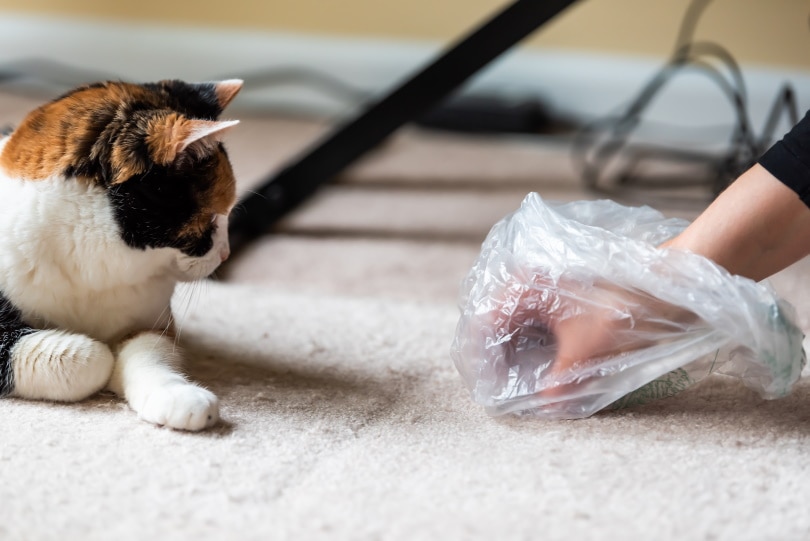
Hardwood floors are prone to urine stains, and those dark spots look horrible. Depending on how long it’s been since your domestic animal has relieved itself, there might be a big, disfiguring stain on your floor, ruining the whole thing. In such an event, sanding should be an effective solution. When applied in combination with refinishing, it does, indeed, achieve excellent results.
Essentially, you’ll be removing tiny bits of the hardwood ruined by the pet’s mess. The floor will look a bit weird after you sand it, though, and that’s exactly why we recommended refinishing earlier. Another minor con: while sanding is very strong against stains, it does very little to get rid of the smell. Yes, some soda or vinegar will come in handy here.
10. Hand Scrapers to the Rescue
Sometimes, the damage is so big that even tons of sandpaper can’t handle it. In that case, go with hand scrapers. They are a powerful tool against old, stubborn stains and are available both offline and online for cheap. You probably already have a couple of these in the garage if you like to work with wood. A quick reminder to be very gentle with your scraping so that you don’t remove too much of the hardwood.
But even if the scrapers do leave some tiny marks, grip paper should help smooth them out. Yes, we’re talking about careful hand sanding of the affected areas.
- Related Read: Cost to Install Hardwood Floors (Cost Per Square Foot )
How to Stop Your Pet from Urinating on Hardwood: Tried-and-True Solutions
Alright, now that we know about the most effective remedies against black urine stains, let’s take a quick look at things you can do to stop your pet from ruining hardwood floors in the first place.

Try Neutering/Spaying the Pet
You might wonder how can sterilizing my pet help? Well, it’s one of the most effective ways of stopping your dog or cat from urinating in the house, which, essentially, is territory marking. However, this should be done as soon as possible while the animal is young. In contrast, if they’ve been urine-marking for a long time, neutering (for males) and spaying (for females) won’t be nearly as effective.
Before you go ahead with the procedure, visit a veterinarian. They’ll examine the pet and tell you whether there are any medical issues or not. Now, for some animals, recovery after sterilization can take a lot of time and effort. So, again, talk to a specialist and have them explain to you what to expect. This is especially true for males. Also, if your pet’s pee is black, that can signal serious health issues like blood cell damage or trauma.
Changing the Patterns
Yes, we know this doesn’t sound fun, but if you clean up after the pet regularly, that can help “break the cycle”. The goal here is to try and clean the mess before it gets absorbed by the hardwood floor. By eliminating the odor, you should be able to cut the pet’s ties to that exact spot. The reason: lingering odors are like a magnet for most domestic pets, and by getting rid of them, you can stop this behavior.
Another helpful trick is to start playing with the dog/cat or feeding them in the areas that they mark to change their patterns. Next, think about the objects and items that might trigger this reaction. Any recent purchases should be kept away from the pet’s view and access. New members of the family (this can be a human or a four-legged creature) also tend to be a problem.
This is going to be a bit of a challenge, and the only way to fix it is to ask the new residents to be friendly towards your day-one cat or dog. We’re talking about creating a safe environment.
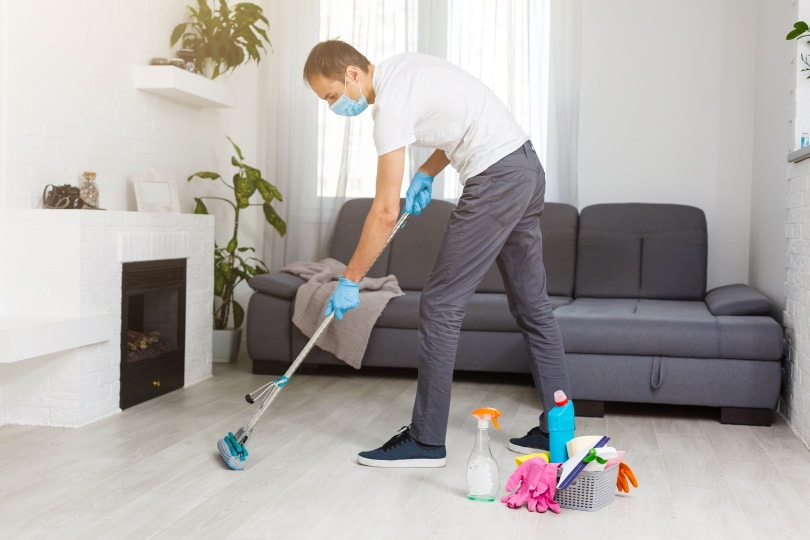
Frequent Breaks Might Help
Every animal is different, and that applies to their bodies as well. Some animals can hold it for longer, while others need frequent breaks. It’s recommended to let your pet out once an hour during the day. Some people insist on training dogs and cats, but that can only be efficient to a certain extent. It’s very important not to punish your fluffy friend for not making it to the “bathroom.” Instead, be friendly, and they’ll start giving you cues.
The breed, size, and, of course, age should also be considered. And a veterinarian will tell you if frequent urination is normal for your pet or not.
Conclusion
When left untreated, pet urine stains can turn into one big mess. On the bright side, there are several quick and easy solutions to this problem. Today, we checked out 10 tried-and-true methods of removing stubborn black pee stains, including “folk remedies” like, say, baking soda or regular dish soap. Next, we talked about using chemicals and cleaning products.
Enzymatic cleaners, bleach, and scrapers have proven their efficiency in real-world tests. These are available at a fair price and take minimal effort to use. Therefore, it would be best if you have at least some of these products/solutions within reach so that you can promptly and effectively tackle urine stains. Take care of your pet, make sure it’s healthy, and check back with us for the latest updates!
Featured Image Credit: Pixel-Shot, Shutterstock
Contents


